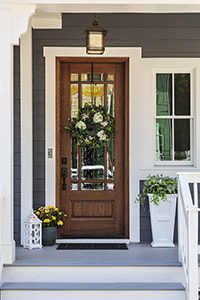 Your home's front exterior—the lawn, landscaping, siding, and front door—is what passersby see from the street. It's called curb appeal, and it's a key factor in promoting the sale of your home. Curb appeal is the first impression a potential homebuyer will have of your home, and the first quick assessment they will make before they even step foot inside the door. Use these ideas to make your home stand out and catch buyers' attention. Freshen Up Your Front Door Make your front door livelier with a fresh coat of paint. Choose black paint for a classic, elegant mood; white for a fresh, crisp appeal; red for an energetic, inviting appearance; or blue for an uplifting, calming feel. Hang a seasonal wreath on your freshly painted front door, and add a shiny door knocker, kick plate, and door handle as finishing touches. Replace an old doorbell with a modern substitute, and exchange small, faded house numbers for large, bold replacements. Frame Your Windows If you want to set apart your home's curb appeal from similar real estate listings, it's all in the details. Framing your front windows with chic shutters adds charming character. Coordinate your shutter selection to complement the architectural style and existing color of your home. Install rustic board-and-batten shutters to enhance a French country style, or mount traditional black shutters to add classic vibes to a white farmhouse design. Window boxes full of beautiful greenery and flowers all heighten visual appeal. Redo Your Front Porch Updating a lifeless front porch will add energy and create much-improved curb appeal for your home. Paint an aged concrete porch with paint designed for outdoor porches and floors. White will brighten up the space, while gray is an alternative neutral that shows less dirt and scuffs. Hang an inviting porch swing from the ceiling of a large, covered porch, or add a stylish bistro table to a smaller porch. A pretty outdoor area rug adds comfort, texture, and color. Hang a few robust plants from your porch ceiling or posts for gorgeous, natural accents. If your overhead light outside your front door is outdated, choose a stylish alternative to give your front porch modern appeal. Real estate listings with great curb appeal get more buyer interest and usually sell for more. Evaluate the curb appeal of your home and use these tips to upgrade and revamp the areas that need improvement.
0 Comments
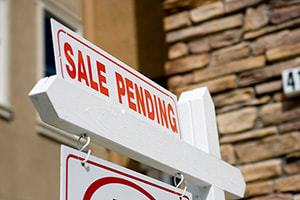 For the 107th month in a row, national home prices climbed year over year, according to the National Association of Realtors (NAR). Every sales region in the country posted price increases, with the median existing-home price rising 14.1% from a year earlier. The rising sales prices, however, did little to deter buyers, as every sales region posted year-over-year double-digit increases in existing-home sales. When comparing month-over-month sales activity, rates varied from region to region. The demand for homes is reflected in the rate at which homes are remaining on the market. In January, the average home sold in just 21 days, unchanged from December but down significantly from the 43 days a home remained available just a year ago. Of all the homes sold in January 2021, 71% were sold in under one month. Buyers Compete for Scarce Listings The high demand for homes is reflected in the ongoing housing shortage. At the end of January, there were just 1.04 million homes available for sale, down 25.7% year over year. NAR has never recorded a decline in inventory so severe. At the current sales pace, the stock of houses would supply the market for only 1.9 months, unchanged from December but down from the 3.1-month supply recorded a year ago. According to Lawrence Yun, chief economist for NAR, "Home sales continued to ascend in the first month of the year, as buyers quickly snatched up virtually every new listing coming on the market." He adds that sales could have been as much as 20% higher if there was more inventory on the market and buyers had more choices. Housing Remains a Bright Spot in U.S. Economy Unlike other parts of the U.S. economy, the housing market seems to be immune to the effects of COVID-19. In every tracked metro area, home prices increased during 2020's fourth quarter. "Home sales are continuing to play a part in propping up the economy," said Yun. "With additional stimulus likely to pass and several vaccines now available, the housing outlook looks solid for this year." In addition, as employment rates continue to improve, homebuying is expected to increase in the coming months. According to Yun, existing-home sales will climb to a minimum of 6.5 million in 2021. Though he predicts rising mortgage rates due to budget deficits and climbing inflation, Yun believes sales will remain strong. First-Time Buyers See Potential First-time buyers accounted for 33% of all purchases in January, up from 31% a month ago and 32% a year ago. According to the NAR "2020 Profile of Home Buyers and Sellers," first-time buyers made up 31% of the buying public in 2020. Individual investors and second-home buyers—a group who account for most all-cash sales—were responsible for 15% of all home purchases, up from 14% in December but down from 17% in January 2020. Of all sales transactions, 19% were all cash, unchanged from a month ago but down from 21% a year ago. Meanwhile, distressed sales—including foreclosures and short sales—accounted for fewer sales, representing just 1% of all transactions in January. This was unchanged from a month ago but down 2% from January 2020. Regional Breakdown Nationwide, January's existing-home sales climbed to a seasonally adjusted annual rate of 6.69 million. This was a 0.6% increase month over month and a 23.7% increase year over year. Northeast - Existing-home sales annual rate of 870,000; a decrease of 2.2% from December 2020 but an increase of 24.3% from January 2020. The median sales price, $361,400, increased 15.8% from January 2020. Midwest - Existing-home sales annual rate of 1.57 million; an increase of 1.9% from December 2020 and 22.7% from January 2020. The median sales price, $227,800, increased 14.7% from January 2020. South - Existing-home sales annual rate of 2.94 million; an increase of 3.2% from December 2020 and 25.1% from January 2020. The median sales price, $263,300, increased 14.6% from January 2020. West - Existing-home sales annual rate of 1.31 million; a decrease of 4.4% from December 2020 but an increase of 21.3% from January 2020. The median sales price, $461,800, increased 16.1% from January 2020. 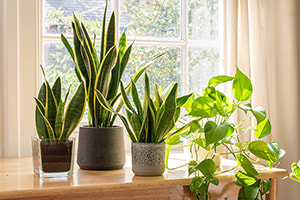 Houseplants are often the bane of busy people. Unlike pets, they have no voice to plead for a drink of water or food. They cannot crawl out of their crowded pots or move to a sunny spot. Completely dependent on our care, they seemingly thrive for a week or two before suddenly dying. So what can you do to keep your houseplants alive and growing? Follow these simple tips that will make your plants happy enough to produce chlorophyll (the green pigment), stand up straight, and maybe even force out some flower buds. Put your plants on a watering schedule. Write it on a calendar in advance. Dedicate a day each week to checking the moisture level in your houseplants’ soil and watering when necessary. Do not overfeed. Using plant food too aggressively can burn a plant’s roots, killing it from the ground up. Feed every couple of months—and that’s only if you remember to water regularly! Repot when necessary. Houseplants that have survived the years are often forgotten in their too-tight planters. Keep a bag of potting soil handy so that you can repot when their roots are straining against the terracotta bowl or peering over the porcelain planter. Follow the care instructions. Some plants love to bask in the sunlight, while others hide in the shade. Still others are somewhere in the middle. Find the proper window for your little beauties, and they will be more willing to blossom under your care. If they seem to be adjusting poorly to one location, move to another less-extreme spot (but don’t go from direct sun to full shade—this will shock the poor thing!). Dust your plants. That’s right—even if you don’t dust the furniture. Take a damp cloth to the leaves. This will keep them shiny and allow them to “breathe.” After all, if they’re under a layer of grime, you can’t see that they’re alive and green! Taking care of houseplants shouldn’t be a chore, even though it may seem like one. Following these few simple guidelines will help you keep your plants green and growing—at least until you go on vacation. 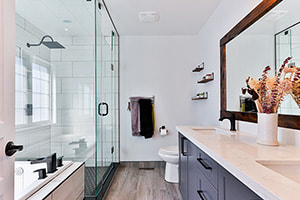 A bathroom remodel is one of the most common home improvement projects, and for good reason; a bathroom remodel can be as simple or as complex as a homeowner desires, and the work is contained to a small area of the home. Here are a few signs that your bathroom could use a remodel: Leaking: Dripping faucets or pipes caused by old fittings or worn out sealant not only waste water but may even cause water damage to your home over time. Prevent potential home maintenance issues by replacing old fixtures with sleek modern fixtures that will give your bathroom style and conserve water. Fixtures are easy to install, which makes this project a good starting point for a bathroom remodel. Changing Needs: Lifestyle changes are another good reason for remodeling a bathroom. It's inevitable that your needs for any living space will change over time, and your bathroom is no exception to this. Perhaps you need to expand the functionality of your bathroom to accommodate the increased use brought on by additional people living in your home. Or health and mobility issues may require slip resistant floors, a wider doorway or features such as a handrail. Water Staining: If your sink, toilet or shower has developed unsightly water stains it’s time to look into resurfacing or replacement. Modern sink, bath and toilet surfaces are much more resistant to water stains and will look new with minimal cleaning for years to come. You’re Ready to Sell: If you’re considering listing your home, then a bathroom remodel is a great idea. Your bathroom is one of the easiest places for you to add value to your home. A comfortable, well-designed bathroom with useful features is one of the main things that homebuyers look for as they evaluate a property, so make sure to complete your remodel before you put your home on the market.  Low inventories for homes across the United States have created a seller’s market. When the supply of homes on the market is low and the demand is high, prices rise and buyers often have to compete against one another. How do you win when there are multiple offers on the table? A home that’s in good shape and priced right will have homebuyers vying for it within days—or even hours—of hitting the market. The potential buyer with the most attractive offer is likely to wind up winning. Here are three tips for making a strong offer: Make Your Best Offer First In a seller’s market, in which there are lots of competing buyers, homes usually sell at or above asking price. If you make an offer and there are multiple offers higher than yours, you likely won’t get a counteroffer. If you have a price in mind that you’re willing to pay for a home you love and you can afford the payments that go with it, it’s a good idea to make your best offer first. A low-ball offer can kill negotiations before they even start. Be Flexible with the Timeline The timeline of the sales process is often important to sellers. They might have mortgage payments on their new home starting soon and will push for a fast close, or if they don’t have another place yet, they’ll want to push back the closing date as long as possible. When making an offer, it’s reasonable to consider the seller’s timing wishes. If you can be flexible, your offer will be more appealing. Are You Willing to Waive It? The less contingencies, the more attractive your offer will be. You may be tempted to waive your right to a home inspection or the inspection contingency that allows you to back out of the sales contract. Similarly, you might be willing to forgo an appraisal contingency, which would mean you’d bring more money to the table at closing. Remember, contingencies are mostly in place to protect homebuyers. It’s important to consult with an experienced real estate agent before agreeing to waive any protections. It can be nerve-wracking to be a homebuyer in a seller’s market. The excitement that comes with finding the perfect home can quickly disappear when you find out the home has multiple offers. Make your best offer upfront and be as flexible as possible to ensure a good chance at securing your dream home. 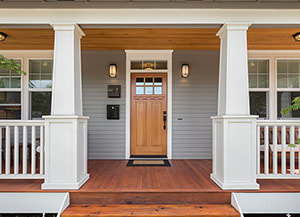 According to the National Association of Realtors (NAR), 2020 home sales climbed to the highest level seen since 2006. The year closed with positive gains in existing-home sales, with every sales region in the country posting double-digit year-over-year increases in December. Median existing-home prices were also up in every region, rising an average of 12.9% from a year earlier. December marked the 106th consecutive month of year-over-year price gains. According to Lawrence Yun, chief economist for NAR, the housing market should continue to show strength in the coming months. “Although mortgage rates are projected to increase, they will continue to hover near record lows at around 3%. Moreover,” he adds, “expect economic conditions to improve with additional stimulus forthcoming and vaccine distribution already underway.” Fewer Listings to Choose From The rise in home prices can be attributed in part to the lack of supply. In December, total housing inventory fell 16.4% from a month earlier and 23% from a year earlier. At the current sales pace, all unsold inventory would supply the market for only 1.9 months —an all-time low. In comparison, there was a 2.3-month supply available in November 2020 and a 3.0-month supply in December 2019. Homebuilders and construction companies are helping to alleviate the shortage of homes; housing starts reached an annual rate of close to 1.7 million, with a high percentage of that focused on single-family homes. However, according to Yun, “It will take vigorous new home construction in 2021 and in 2022 to adequately furnish the market to properly meet the demand.” Properties Flying off the Market One consequence of high demand and low supply is that homes are being sold in record time due to increased competition. In December, the average property remained on the market for only 21 days, unchanged from a month earlier but down from the 41 days recorded in December 2019. Of all the homes on the market in December 2020, 70% sold in less than one month. Who’s Buying Homes? First-time buyers remained optimistic about the housing market. This group accounted for 31% of all sales in December, unchanged from a year earlier. According to the NAR “2020 Profile of Home Buyers and Sellers,” first-time buyers made up 31% of all buyers in 2020. Individual investors and second-home buyers—a group responsible for many cash sales—accounted for 14% of all market activity in December. All-cash sales made up 19% of December’s transactions. Foreclosures and short sales accounted for less than 1% of all sales. Regional Breakdown for December 2020 Northeast - Existing-home sales annual rate of 930,000; an increase of 4.5% from November 2020 and 27.4% from December 2019. At $362,100, the median sales price increased 19% from December 2019. Midwest - Existing-home sales annual rate of 1.59 million; sales remained unchanged from November 2020 but increased 26.2% from December 2019. At $235,700, the median sales price increased 13.7% from December 2019. South - Existing-home sales annual rate of 2.86 million; an increase of 1.1% from November 2020 and 20.7% from December 2019. At $268,100, the median sales price increased 11.3% from December 2019. West - Existing-home sales annual rate of 1.38 million; a decrease of 1.4% from November 2020 but an increase of 17.9% from December 2019. At $467,900, the median sales price increased 14.2% from December 2019.  What You Should Know Before Buying a Home
|
AuthorBe informed with the latest real estate news and useful real estate related information. Archives
March 2025
Categories
|
